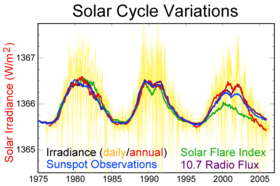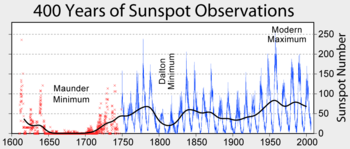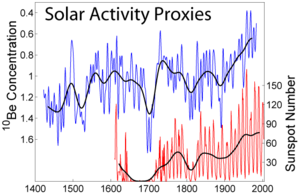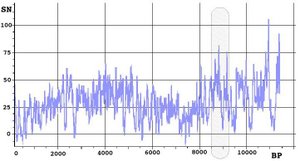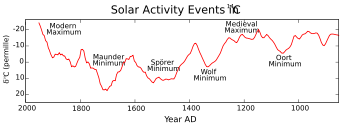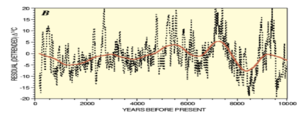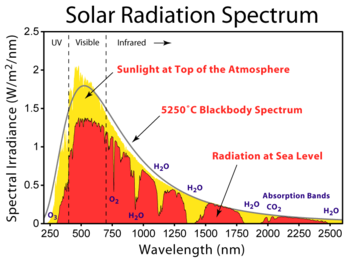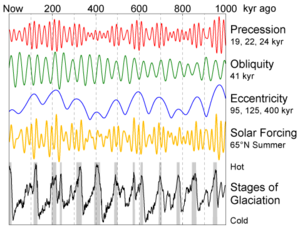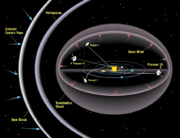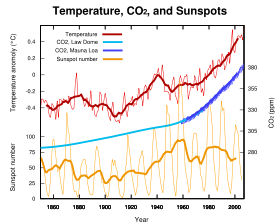Solar variation
2008/9 Schools Wikipedia Selection. Related subjects: Climate and the Weather
Solar variations are changes in the amount of radiant energy emitted by our Sun. There are periodic components to these variations, the principal one being the 11-year solar cycle (or sunspot cycle), as well as fluctuations which are aperiodic. Solar activity has been measured via satellites during recent decades and through 'proxy' variables in prior times. Climate scientists are interested in understanding what, if any, effect variations in solar activity have on the Earth. Any such mechanism is referred to as "solar forcing".
The variations in total solar irradiance (TSI) remained at or below the threshold of detectability until the satellite era, although the small fraction in ultra-violet wavelengths varies by a few percent. Total solar output is now measured to vary (over the last three 11-year sunspot cycles) by approximately 0.1% or about 1.3 W/m2 peak-to-trough during the 11 year sunspot cycle. The amount of solar radiation received at the outer surface of Earth's atmosphere varied little from an average value of 1366 watts per square meter (W/m2). There are no direct measurements of the longer-term variation and interpretations of proxy measures of variations differ; recent results suggest about 0.1% variation over the last 2000 years, although other sources suggest a 0.2% increase in solar irradiance since 1675. The combination of solar variation and volcanic effects has very likely been the cause of some climate change, for example during the Maunder Minimum. A 2006 study and review of existing literature, published in Nature, determined that there has been no net increase in solar brightness since the mid 1970s, and that changes in solar output within the past 400 years are unlikely to have played a major part in global warming. It should be stressed, the same report cautions that "Apart from solar brightness, more subtle influences on climate from cosmic rays or the Sun's ultraviolet radiation cannot be excluded, say the authors. However, these influences cannot be confirmed, they add, because physical models for such effects are still too poorly developed."
History of study into solar variations
The longest recorded aspect of solar variations are changes in sunspots. The first record of sunspots dates to around 800 BC in China and the oldest surviving drawing of a sunspot dates to 1128. In 1610, astronomers began using the telescope to make observations of sunspots and their motions. Initial study was focused on their nature and behaviour. Although the physical aspects of sunspots were not identified until the 1900s, observations continued. Study was hampered during the 1600s and 1700s due to the low number of sunspots during what is now recognized as an extended period of low solar activity, known as the Maunder Minimum. By the 1800s, there was a long enough record of sunspot numbers to infer periodic cycles in sunspot activity. In 1845, Princeton University professors Joseph Henry and Stephen Alexander observed the Sun with a thermopile and determined that sunspots emitted less radiation than surrounding areas of the Sun. The emission of higher than average amounts of radiation later were observed from the solar faculae.
Around 1900, researchers began to explore connections between solar variations and weather on Earth. Of particular note is the work of Charles Greeley Abbot. Abbot was assigned by the Smithsonian Astrophysical Observatory (SAO) to detect changes in the radiation of the Sun. His team had to begin by inventing instruments to measure solar radiation. Later, when Abbot was head of the SAO, it established a solar station at Calama, Chile to complement its data from Mount Wilson Observatory. He detected 27 harmonic periods within the 273-month Hale cycles, including 7, 13, and 39 month patterns. He looked for connections to weather by means such as matching opposing solar trends during a month to opposing temperature and precipitation trends in cities. With the advent of dendrochronology, scientists such as Waldo S. Glock attempted to connect variation in tree growth to periodic solar variations in the extant record and infer long-term secular variability in the solar constant from similar variations in millennial-scale chronologies.
Statistical studies that correlate weather and climate with solar activity have been popular for centuries, dating back at least to 1801, when William Herschel noted an apparent connection between wheat prices and sunspot records . They now often involve high-density global datasets compiled from surface networks and weather satellite observations and/or the forcing of climate models with synthetic or observed solar variability to investigate the detailed processes by which the effects of solar variations propagate through the Earth's climate system.
Solar activity
Sunspots
Sunspots are relatively dark areas on the surface of the Sun where intense magnetic activity inhibits convection and so cools the surface. The number of sunspots correlates with the intensity of solar radiation. The variation is small (of the order of 1 W/m² or 0.1% of the total) and was only established once satellite measurements of solar variation became available in the 1980s. Based on work by Abbot, Foukal et al. (1977) realised that higher values of radiation are associated with more sunspots. Nimbus 7 (launched October 25, 1978) and the Solar Maximum Mission (launched February 14, 1980) detected that because the areas surrounding sunspots are brighter, the overall effect is that more sunspots means a brighter sun.
There had been some suggestion that variations in the solar diameter might cause variations in output. But recent work, mostly from the Michelson Doppler Imager instrument on SOHO, shows these changes to be small, about 0.001% (Dziembowski et al., 2001).
Various studies have been made using sunspot number (for which records extend over hundreds of years) as a proxy for solar output (for which good records only extend for a few decades). Also, ground instruments have been calibrated by comparison with high-altitude and orbital instruments. Researchers have combined present readings and factors to adjust historical data. Other proxy data - such as the abundance of cosmogenic isotopes - have been used to infer solar magnetic activity and thus likely brightness.
Sunspot activity has been measured using the Wolf number for about 300 years. This index (also known as the Zürich number) uses both the number of sunspots and the number of groups of sunspots to compensate for variations in measurement. A 2003 study by Ilya Usoskin of the University of Oulu, Finland found that sunspots had been more frequent since the 1940s than in the previous 1150 years.
Sunspot numbers over the past 11,400 years have been reconstructed using dendrochronologically dated radiocarbon concentrations. The level of solar activity during the past 70 years is exceptional - the last period of similar magnitude occurred over 8,000 years ago. The Sun was at a similarly high level of magnetic activity for only ~10% of the past 11,400 years, and almost all of the earlier high-activity periods were shorter than the present episode.
| Event | Start | End |
|---|---|---|
| Oort minimum (see Medieval Warm Period) | 1040 | 1080 |
| Medieval maximum (see Medieval Warm Period) | 1100 | 1250 |
| Wolf minimum | 1280 | 1350 |
| Spörer Minimum | 1450 | 1550 |
| Maunder Minimum | 1645 | 1715 |
| Dalton Minimum | 1790 | 1820 |
| Modern Maximum | 1950 | ongoing |
Solar cycles
Solar cycles are cyclic changes in behaviour of the Sun. Many possible patterns have been suggested; only the 11 and 22 year cycles are clear in the observations.
- 11 years: Most obvious is a gradual increase and decrease of the number of sunspots over a period of about 11 years, called the Schwabe cycle and named after Heinrich Schwabe. The Babcock Model explains this as being due to a shedding of entangled magnetic fields. The Sun's surface is also the most active when there are more sunspots, although the luminosity does not change much due to an increase in bright spots ( faculae).
- 22 years: Hale cycle, named after George Ellery Hale. The magnetic field of the Sun reverses during each Schwabe cycle, so the magnetic poles return to the same state after two reversals.
- 87 years (70-100 years): Gleissberg cycle, named after Wolfgang Gleißberg, is thought to be an amplitude modulation of the 11-year Schwabe Cycle (Sonnett and Finney, 1990).Braun, et al, (2005)
- 210 years: Suess cycle (a.k.a. de Vries cycle). Braun, et al, (2005).
- 2,300 years: Hallstatt cycle
Other patterns have been detected:
- In carbon-14: 105, 131, 232, 385, 504, 805, 2,241 years (Damon and Sonnett, 1991).
- During the Upper Permian 240 million years ago, mineral layers created in the Castile Formation show cycles of 2,500 years.
The sensitivity of climate to cyclical variations in solar forcing will be higher for longer cycles due to the thermal inertia of the ocean, which acts to damp high frequencies. Scafetta and West (2005) found that the climate was 1.5 times as sensitive to 22 year cyclical forcing relative to 11 year cyclical forcing, and that the thermal inertial induced a lag of approximately 2.2 years in cyclic climate response in the temperature data.
Predictions based on patterns
- A simple model based on emulating harmonics by multiplying the basic 11-year cycle by powers of 2 produced results similar to Holocene behaviour. Extrapolation suggests a gradual cooling during the next few centuries with intermittent minor warmups and a return to near Little Ice Age conditions within the next 500 years. This cool period then may be followed approximately 1,500 years from now by a return to altithermal conditions similar to the previous Holocene Maximum.
- There is weak evidence for a quasi-periodic variation in the sunspot cycle amplitudes with a period of about 90 years. These characteristics indicate that the next solar cycle should have a maximum smoothed sunspot number of about 145±30 in 2010 while the following cycle should have a maximum of about 70±30 in 2023.
- Because carbon-14 cycles are quasi periodic, Damon and Sonett (1989) predict future climate:
| Cycle length | Cycle name | Last positive carbon-14 anomaly |
Next "warming" |
|---|---|---|---|
| 232 | --?-- | AD 1922 (cool) | AD 2038 |
| 208 | Suess | AD 1898 (cool) | AD 2002 |
| 88 | Gleisberg | AD 1986 (cool) | AD 2030 |
Solar irradiance of Earth and its surface
Solar irradiance, or insolation, is the amount of sunlight which reaches the Earth. The equipment used might measure optical brightness, total radiation, or radiation in various frequencies. Historical estimates use various measurements and proxies.
There are two common meanings:
- the radiation reaching the upper atmosphere
- the radiation reaching some point within the atmosphere, including the surface.
Various gases within the atmosphere absorb some solar radiation at different wavelengths, and clouds and dust also affect it. Hence measurements above the atmosphere are needed to observe variations in solar output, within the confounding effects of changes to the atmosphere. Indeed, there is some evidence that sunshine at the Earth's surface has been decreasing in the last 50 years (see global dimming) possibly caused by increased atmospheric pollution, whilst over roughly the same timespan solar output has been nearly constant.
Milankovitch cycle variations
Some variations in insolation are not due to solar changes but rather due to the Earth moving closer or further from the Sun, or changes in the relative amount of radiation reaching regions of the Earth. These have caused variations of as much as 25% (locally; global average changes are much smaller) in solar insolation over long periods. The most recent significant event was an axial tilt of 24° during boreal summer at near the time of the Holocene climatic optimum.
Solar interactions with Earth
There are several hypotheses for how solar variations may affect Earth. Some variations, such as changes in the size of the Sun, are presently only of interest in the field of astronomy.
Changes in total irradiance
- Overall brightness may change.
- The variation during recent cycles has been about 0.1%.
- Changes corresponding to solar changes with periods of 9-13, 18-25, and >100 years have been measured in sea-surface temperatures.
- Since the Maunder Minimum, over the past 300 years there probably has been an increase of 0.1 to 0.6%, with climate models often using a 0.25% increase.
- One reconstruction from the ACRIM data show a 0.05% per decade trend of increased solar output between solar minima over the short span of the data set. These display a high degree of correlation with solar magnetic activity as measured by Greenwich Sunspot Number. Wilson, Mordvinov (2003)
Changes in ultraviolet irradiance
- Ultraviolet irradiance (EUV) varies by approximately 1.5 percent from solar maxima to minima, for 200 to 300 nm UV.
- Energy changes in the UV wavelengths involved in production and loss of ozone have atmospheric effects.
- The 30 hPa atmospheric pressure level has changed height in phase with solar activity during the last 4 solar cycles.
- UV irradiance increase causes higher ozone production, leading to stratospheric heating and to poleward displacements in the stratospheric and tropospheric wind systems.
- A proxy study estimates that UV has increased by 3% since the Maunder Minimum.
Changes in the solar wind and the Sun's magnetic flux
- A more active solar wind and stronger magnetic field reduces the cosmic rays striking the Earth's atmosphere.
- Variations in the solar wind affect the size and intensity of the heliosphere, the volume larger than the Solar System filled with solar wind particles.
- Cosmogenic production of 14C, 10Be and 36Cl show changes tied to solar activity.
- Cosmic ray ionization in the upper atmosphere does change, but significant effects are not obvious.
- As the solar coronal-source magnetic flux doubled during the past century, the cosmic-ray flux has decreased by about 15%.
- The Sun's total magnetic flux rose by a factor of 1.41 from 1964-1996 and by a factor of 2.3 since 1901.
Effects on clouds
- Cosmic rays have been hypothesized to affect formation of clouds through possible effects on production of cloud condensation nuclei. Observational evidence for such a relationship is, at best, inconclusive.
- 1983-1994 data from the International Satellite Cloud Climatology Project (ISCCP) showed that global low cloud formation was highly correlated with cosmic ray flux; subsequent to this the correlation breaks down
- The Earth's albedo decreased by about 2.5% over 5 years during the most recent solar cycle, as measured by lunar "Earthshine". Similar reduction was measured by satellites during the previous cycle.
- Mediterranean core study of plankton detected a solar-related 11 year cycle, and an increase 3.7 times larger between 1760 and 1950. A considerable reduction in cloud cover is proposed.
- A laboratory experiment conducted by Henrik Svensmark at the Danish National Space Centre was able to produce particles as a result of cosmic ray-like irradiation, though these particles do not resemble actual cloud condensation nuclei found in nature.
Other effects due to solar variation
Interaction of solar particles, the solar magnetic field, and the Earth's magnetic field, cause variations in the particle and electromagnetic fields at the surface of the planet. Extreme solar events can affect electrical devices. Weakening of the Sun's magnetic field is believed to increase the number of interstellar cosmic rays which reach Earth's atmosphere, altering the types of particles reaching the surface. It has been speculated that a change in cosmic rays could cause an increase in certain types of clouds, affecting Earth's albedo.
Geomagnetic effects
The Earth's polar aurorae are visual displays created by interactions between the solar wind, the solar magnetosphere, the Earth's magnetic field, and the Earth's atmosphere. Variations in any of these affect aurora displays.
Sudden changes can cause the intense disturbances in the Earth's magnetic fields which are called geomagnetic storms.
Solar proton events
Energetic protons can reach Earth within 30 minutes of a major flare's peak. During such a solar proton event, Earth is showered in energetic solar particles (primarily protons) released from the flare site. Some of these particles spiral down Earth's magnetic field lines, penetrating the upper layers of our atmosphere where they produce additional ionization and may produce a significant increase in the radiation environment.
Galactic cosmic rays
An increase in solar activity (more sunspots) is accompanied by an increase in the " solar wind," which is an outflow of ionized particles, mostly protons and electrons, from the sun. The Earth's geomagnetic field, the solar wind, and the solar magnetic field deflect galactic cosmic rays (GCR). A decrease in solar activity increases the GCR penetration of the troposphere and stratosphere. GCR particles are the primary source of ionization in the troposphere above 1 km (below 1 km, radon is a dominant source of ionization in many areas).
Levels of GCRs have been indirectly recorded by their influence on the production of carbon-14 and beryllium-10. The Hallstatt solar cycle length of approximately 2300 years is reflected by climatic Dansgaard-Oeschger events. The 80-90 year solar Gleissberg cycles appear to vary in length depending upon the lengths of the concurrent 11 year solar cycles, and there also appear to be similar climate patterns occurring on this time scale.
Cloud effects
Changes in ionization affect the abundance of aerosols that serve as the nuclei of condensation for cloud formation. As a result, ionization levels potentially affect levels of condensation, low clouds, relative humidity, and albedo due to clouds. Clouds formed from greater amounts of condensation nuclei are brighter, longer lived, and likely to produce less precipitation. Changes of 3-4% in cloudiness and concurrent changes in cloud top temperatures have been correlated to the 11 and 22 year solar (sunspot) cycles, with increased GCR levels during "antiparallel" cycles. Global average cloud cover change has been found to be 1.5-2%. Several studies of GCR and cloud cover variations have found positive correlation at latitudes greater than 50° and negative correlation at lower latitudes. However, not all scientists accept this correlation as statistically significant, and some that do attribute it to other solar variability (e.g. UV or total irradiance variations) rather than directly to GCR changes. Difficulties in interpreting such correlations include the fact that many aspects of solar variability change at similar times, and some climate systems have delayed responses.
Carbon-14 production
The production of carbon-14 (radiocarbon: 14C) also is related to solar activity. Carbon-14 is produced in the upper atmosphere when cosmic ray bombardment of atmospheric nitrogen (14N) changes the Nitrogen into an unusual form of Carbon with an atomic weight of 14 rather than the more common 12. Paradoxically, increased solar activity results in a reduction of cosmic rays reaching the earth's atmosphere and reduces 14C production. This is because cosmic rays are partially excluded from the Solar System by the outward sweep of magnetic fields in the solar wind. Thus the cosmic ray intensity and carbon-14 production vary oppositely to the general level of solar activity .
Therefore, the 14C concentration of the atmosphere is lower during sunspot maxima and higher during sunspot minima. By measuring the captured 14C in wood and counting tree rings, production of radiocarbon relative to recent wood can be measured and dated. A reconstruction of the past 10,000 years shows that the 14C production was much higher during the mid- Holocene 7,000 years ago and decreased until 1,000 years ago. In addition to variations in solar activity, the long term trends in carbon-14 production are influenced by changes in the Earth's geomagnetic field and by changes in carbon cycling within the biosphere (particularly those associated with changes in the extent of vegetation since the last ice age).
Global warming
Researchers have correlated solar variation with changes in the Earth's average temperature and climate - sometimes finding an effect, and sometimes not. Researchers who have found an effect include Willie Soon and Sallie Baliunas or Douglass and Clader, Geophysical Research Letters, 2002.
The IPCC questions the magnitude of long-term (last hundred or more years) solar variation in section 6.11 of the TAR and show various results including Lean et al. (1995). However the Lean 1995 value may well be too high: more recently Lean et al (GRL 2002,) say:
- Our simulation suggests that secular changes in terrestrial proxies of solar activity (such as the 14C and 10Be cosmogenic isotopes and the aa geomagnetic index) can occur in the absence of long-term (i.e., secular) solar irradiance changes. ...this suggests that total solar irradiance may also lack significant secular trends. ...Solar radiative forcing of climate is reduced by a factor of 5 when the background component is omitted from historical reconstructions of total solar irradiance ...This suggest that general circulation model (GCM) simulations of twentieth century warming may overestimate the role of solar irradiance variability. ...There is, however, growing empirical evidence for the Sun's role in climate change on multiple time scales including the 11-year cycle ...Climate response to solar variability may involve amplification of climate modes which the GCMs do not typically include. ...In this way, long-term climate change may appear to track the amplitude of the solar activity cycles because the stochastic response increases with the cycle amplitude, not because there is an actual secular irradiance change.
More recently, a study and review of existing literature published in Nature in Sept. 2006 suggests that the evidence is solidly on the side of solar brightness having relatively little effect on global climate, and downplays the likelihood of significant shifts in solar output over long periods of time.
Lockwood and Frölich, 2007, find that there "is considerable evidence for solar influence on the Earth’s pre-industrial climate and the Sun may well have been a factor in post-industrial climate change in the first half of the last century. Here we show that over the past 20 years, all the trends in the Sun that could have had an influence on the Earth’s climate have been in the opposite direction to that required to explain the observed rise in global mean temperatures." This is now however disputed by a recent reply by Svensmark and Friis-Christensen which concludes that tropospheric air temperature records, as opposed to the surface air temperature data used by Lockwood and Fröhlich, do show a significant negative correlation between cosmic-ray flux and air temperatures up to 2006. They also point out that Lockwood and Fröhlich present their data by using running means of around 10 years, which shows a constant temperature rise. This reply has so far not been published in a peer-reviewed journal.
Solar variation theory
There have been proposals that variations in solar output explain past climate change and contribute to global warming. The most accepted influence of solar variation on the climate is through direct radiative forcing. Various hypotheses have been proposed to explain the apparent solar correlation with temperatures that some assert appear to be stronger than can be explained by direct irradiation and the first order positive feedbacks to increases in solar activity. The meteorological community has responded with skepticism, in part because theories of this nature have come and gone over the course of the 20th century.
Sami Solanki, the director of the Max Planck Institute for Solar System Research in Katlenburg-Lindau, Germany said:
- The sun has been at its strongest over the past 60 years and may now be affecting global temperatures... the brighter sun and higher levels of so-called "greenhouse gases" both contributed to the change in the Earth's temperature, but it was impossible to say which had the greater impact.
Nevertheless, Solanki agrees with the scientific consensus that the marked upswing in temperatures since about 1980 is attributable to human activity.
- "Just how large this role [of solar variation] is, must still be investigated, since, according to our latest knowledge on the variations of the solar magnetic field, the significant increase in the Earth’s temperature since 1980 is indeed to be ascribed to the greenhouse effect caused by carbon dioxide."
Willie Soon and Sallie Baliunas of the Harvard Observatory correlated historical sunspot counts with temperature proxies. They report that when there are fewer sunspots, the earth cooled (see Maunder Minimum, Little Ice Age) — and that when there are more sunspots the earth warmed (see Medieval Warm Period, though since sunspot numbers were only counted from 1700 the link to the MWP warmth is speculative).
The theories have usually represented one of three types:
- Solar irradiance changes directly affecting the climate. This is generally considered unlikely, as the amplitudes of the variations in solar irradiance are much too small to have the observed relation absent some amplification process.
- Variations in the ultraviolet component having an effect. The UV component varies by more than the total.
- Effects mediated by changes in cosmic rays (which are affected by the solar wind, which is affected by the solar output) such as changes in cloud cover.
Although correlations often can be found, the mechanism behind these correlations is a matter of speculation. Many of these speculative accounts have fared badly over time, and in a paper "Solar activity and terrestrial climate: an analysis of some purported correlations" (J. Atmos. and Solar-Terr. Phy., 2003 p801–812) Peter Laut demonstrates problems with some of the most popular, notably those by Svensmark and by Lassen (below). Damon and Laut report in Eos that the apparent strong correlations displayed on these graphs have been obtained by incorrect handling of the physical data. The graphs are still widely referred to in the literature, and their misleading character has not yet been generally recognized.
In 1991, Knud Lassen of the Danish Meteorological Institute in Copenhagen and his colleague Eigil Friis-Christensen found a strong correlation between the length of the solar cycle and temperature changes throughout the northern hemisphere. Initially, they used sunspot and temperature measurements from 1861 to 1989, but later found that climate records dating back four centuries supported their findings. This relationship appeared to account for nearly 80 per cent of the measured temperature changes over this period (see graph ). Damon and Laut, however, show that when the graphs are corrected for filtering errors, the sensational agreement with the recent global warming, which drew worldwide attention, has totally disappeared. Nevertheless, the authors and other researchers keep presenting the old misleading graph. Note that the prior link to "graph" is one such example of this.
Sallie Baliunas, an astronomer at the Harvard-Smithsonian Centre for Astrophysics, has been among the supporters of the theory that changes in the sun "can account for major climate changes on Earth for the past 300 years, including part of the recent surge of global warming."
On May 6, 2000, however, New Scientist magazine reported that Lassen and astrophysicist Peter Thejll had updated Lassen's 1991 research and found that while the solar cycle still accounts for about half the temperature rise since 1900, it fails to explain a rise of 0.4 °C since 1980. "The curves diverge after 1980," Thejll said, "and it's a startlingly large deviation. Something else is acting on the climate.... It has the fingerprints of the greenhouse effect."
Later that same year, Peter Stott and other researchers at the Hadley Centre in the United Kingdom published a paper in which they reported on the most comprehensive model simulations to date of the climate of the 20th century. Their study looked at both " natural forcing agents" (solar variations and volcanic emissions) as well as " anthropogenic forcing" (greenhouse gases and sulphate aerosols). They found that "solar effects may have contributed significantly to the warming in the first half of the century although this result is dependent on the reconstruction of total solar irradiance that is used. In the latter half of the century, we find that anthropogenic increases in greenhouses gases are largely responsible for the observed warming, balanced by some cooling due to anthropogenic sulphate aerosols, with no evidence for significant solar effects." Stott's team found that combining all of these factors enabled them to closely simulate global temperature changes throughout the 20th century. They predicted that continued greenhouse gas emissions would cause additional future temperature increases "at a rate similar to that observed in recent decades". It should be noted that their solar forcing included "spectrally-resolved changes in solar irradiance" and not the indirect effects mediated through cosmic rays for which there is still no accepted mechanism — these ideas are still being fleshed out. In addition, the study notes "uncertainties in historical forcing" — in other words, past natural forcing may still be having a delayed warming effect, most likely due to the oceans. A graphical representation of the relationship between natural and anthropogenic factors contributing to climate change appears in "Climate Change 2001: The Scientific Basis", a report by the Intergovernmental Panel on Climate Change (IPCC).
Stott's 2003 work mentioned in the model section above largely revised his assessment, and found a significant solar contribution to recent warming, although still smaller (between 16 and 36%) than that of the greenhouse gases.
